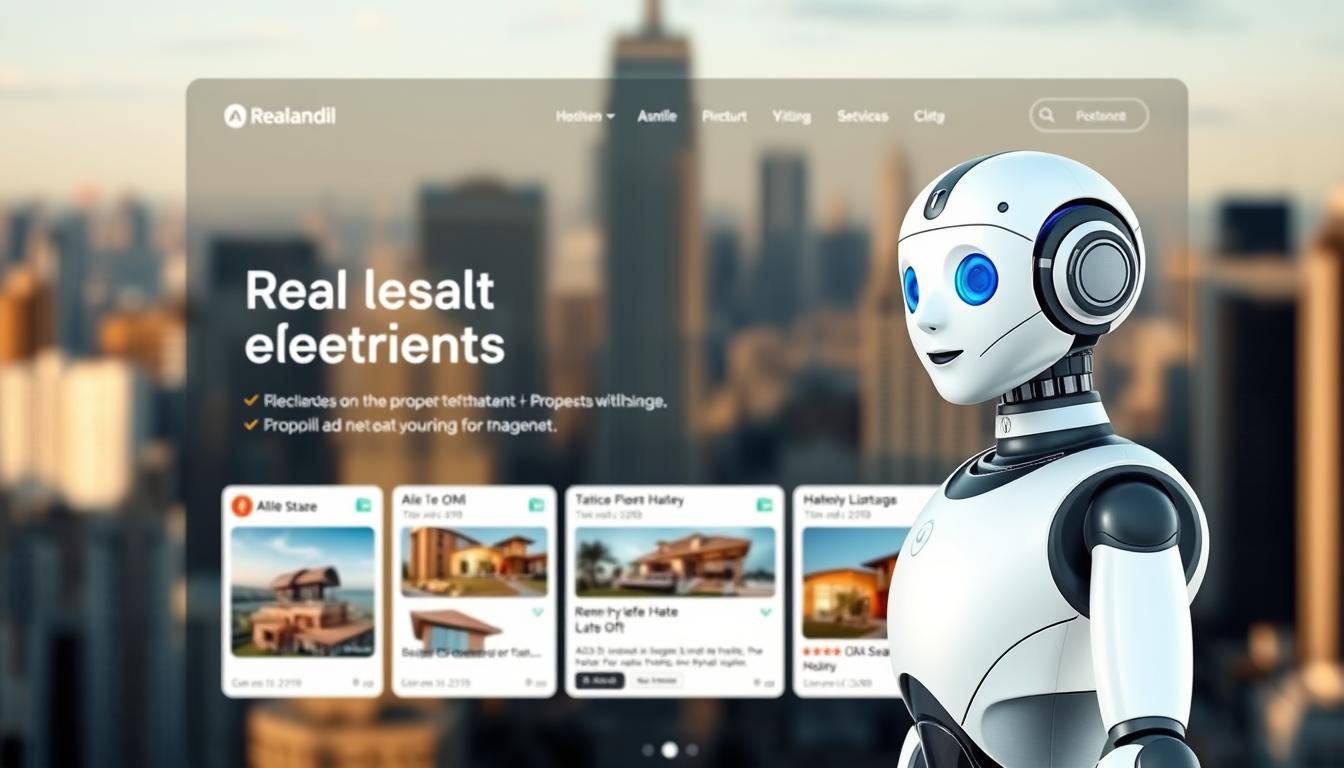I create conversational AI for real estate to turn visitors into leads. An ai chatbot for real estate websites uses large language models. It works with domain-specific logic to capture leads, answer questions, and schedule viewings.
The benefits are clear and quick. It offers instant responses, personalized property discovery, and automated qualification. It’s available 24/7 and captures reliable data for CRM follow-up.
I connect real estate chatbots to MLS/IDX feeds and platforms like Zillow and Realtor.com. I also integrate with CRMs like Salesforce, HubSpot, and Follow Up Boss. This keeps pipelines moving.
This introduction highlights the promise of a real estate chatbot. It reduces response time, boosts conversion rates, and lets agents focus on important conversations. I’ll explain why I suggest an ai chatbot, how I design conversational flows, and the strategies I use. I’ll also discuss the metrics I track and the challenges I solve for U.S. brokerages and agents.
Key Takeaways
- An ai chatbot for real estate websites captures leads instantly and works around the clock.
- Conversational AI real estate tools personalize property discovery and automate qualification.
- Property chatbots integrate with MLS/IDX feeds and CRMs like Salesforce and HubSpot.
- A real estate chatbot improves conversion rates and reduces agent workload.
- I will show practical design, integration, and measurement steps for U.S. brokerages and agents.
Why I Recommend an AI Chatbot for Real Estate Website
I use conversational AI to turn visitors into leads. A good lead capture chatbot real estate engages users right away. It collects contact info and sends it to my CRM. This makes follow-ups more likely.
Immediate lead capture and qualification
I make the first chat quick and focused. I get names, phones, and emails in just a few questions. I also ask about budget, timeframe, bedrooms, and neighborhoods to qualify leads.
24/7 availability to outpace competitors
People look for homes at all hours, not just when agents are available. A 24/7 chatbot answers questions and flags important leads. Urgent leads get sent to agents via SMS or push alerts.
Personalized user journeys that increase conversion rates
AI lets me offer personalized advice based on user preferences. I show listings that match their search and adjust my tone to fit their needs. This makes users more likely to contact me.
I use tools like Drift, Intercom, or Botpress to manage these chats. They connect to Salesforce or Follow Up Boss. This keeps lead data up-to-date and helps automate follow-ups.
How AI Chatbots Improve Customer Engagement on Real Estate Sites
I use chatbots to make browsing faster and more useful for buyers and renters. They turn passive visitors into engaged prospects by understanding intent, surfacing relevant listings, and keeping conversations moving toward a showing or inquiry.
Contextual property recommendations
I train chat flows to parse keywords and intent from short messages and search behavior. This allows a property recommendations chatbot to match price ranges, bedroom counts, school zones, and commute times from MLS or IDX data. I layer geolocation filters and similarity ranking so the bot suggests sensible alternatives when the ideal home is not available.
- I integrate RETS/IDX feeds and APIs like IDX Broker to pull listing metadata.
- I apply intent parsing and attribute filters to narrow results quickly.
- I display ranked matches and let users refine by map, price, or school district.
Interactive property tours and media handling
Users expect rich visuals. A virtual tour chatbot delivers image carousels, floor plans, Matterport embeds, and short walkthrough clips to keep attention on site longer. I serve thumbnails first, then load full galleries on demand to cut load times and improve mobile performance.
- Thumbnails and expandable galleries reduce bounce and boost engagement.
- Captions highlight lot size, HOA fees, and key selling points for each photo.
- Embedding Zillow 3D Home or Matterport tours increases time on page and lead quality.
Seamless follow-ups and appointment scheduling
I build schedule flows that surface available windows from integrated calendars. A schedule showing chatbot syncs with Google Calendar and Microsoft Outlook so agents and clients see real-time availability. I enforce buffer rules and two-way sync to avoid double-booking.
- Propose slots, confirm with a one-tap button, and send SMS or email reminders.
- Automated post-showing follow-ups collect feedback and next-step preferences.
- APIs handle calendar invites and update the CRM record after each interaction.
Combining a property recommendations chatbot, a virtual tour chatbot, a schedule showing chatbot, and a media-rich chatbot real estate approach keeps conversations relevant and moves prospects toward tours and offers. I focus on fast responses, clear media delivery, and reliable calendar sync to reduce friction and lift conversion rates.
Integration Strategies for an AI Chatbot with My Real Estate Tech Stack
I focus on keeping listings up-to-date and capturing leads smoothly. My goal is to ensure real-time data and secure access. I aim for a seamless flow from chat to CRM to calendar. Here are the steps and tools I use to link the chatbot to essential platforms.
Connecting to listing feeds
I make sure the chatbot always shows current listings. I use MLS WebAPI or RETS for updates. If needed, I go through IDX providers like IDX Broker or iHomefinder to standardize data.
For better performance, I use caching. I update fields like status and price often, but keep static fields longer. I follow MLS rules to avoid legal issues. For teams needing a simpler option, I use an IDX feed chatbot.
CRM sync that tracks value
Syncing data in both directions is key. I add new leads and chat logs to Salesforce, HubSpot, Follow Up Boss, or kvCORE right away. I track leads by source and capture important details for reports.
Custom field mapping helps with automation. I set up lead scoring and timeline mapping for drip campaigns. This setup shows the value of the CRM integration.
Calendars and virtual tours
I connect booking to Google Calendar and Microsoft Graph securely. Timezone matching is important for agents across states. My chatbot checks availability, creates events, and sends reminders to reduce no-shows.
For virtual tours, I link to Matterport and iGUIDE. When Matterport chatbot links are available, the chat offers tours and agent info. Without direct API access, I use Zapier or Make for reliable connections.
- Use secure OAuth for calendars and virtual tour APIs.
- Respect MLS licensing with RETS or WebAPI and consider an IDX feed chatbot for normalized data.
- Push chat data into CRM fields for scoring, segmentation, and attribution.
- Implement short cache lifetimes for volatile fields to keep listings current.
- Add middleware as a fallback when native integrations are unavailable.
Designing Conversational Flows That Convert
I create conversational flows that guide visitors from curiosity to action. I use short, valuable prompts that match their intent. This approach respects their time and avoids interrupting their browsing.

Opening messages that reduce bounce rates
I start chats with targeted messages like “Looking for 2‑bed condos in Chicago under $600k?” I test different CTAs, such as “View listings” or “Get a pre-approval checklist.” I avoid auto-invites on long blog pages and let users control the chat.
A/B testing helps me find the best opening message. This reduces bounce rates.
Segmenting users by intent and lifecycle stage
I quickly classify visitors as buyers, renters, sellers, or investors. This initial split helps the chatbot offer tailored flows. For example, sellers get valuation tools, and buyers get affordability calculators.
I tag leads with lifecycle stages like new lead, hot, or nurture. This ensures CRM workflows and agent queues are effective. It keeps follow-ups relevant and focuses agents on high-value prospects.
Handling objections and qualifying buyers vs. renters
I script responses for common concerns like budget and financing. I use empathy and offer quick next steps. For example, I provide mortgage estimates or suggest lower-cost options when budget is a concern.
- I ask a short set of qualifying questions: pre-approval status, buying timeline, and agent representation.
- For renters, I use lease length and move-in date to separate serious prospects from window shoppers.
- If a lead shows high intent, I immediately hand them off to an agent. Lower-intent users get helpful content.
These flows make the chatbot decisive while keeping conversations human and efficient. The result is fewer dead leads, faster agent response, and better use of agent time.
Measuring Success: Metrics I Track for My AI Chatbot
I keep an eye on a few key metrics to see how my chatbot helps the business. These numbers help me fine-tune the chatbot and decide where to spend my budget. I look at how chats lead to deals and how they make agents’ work better.
Lead volume and lead-to-client conversion rate
I watch how many leads the chatbot brings in and how many are good leads. I see how many chats turn into appointments and appointments into deals. I also compare the cost of getting a lead to the cost of closing a deal. This helps me test and improve the chatbot’s lead conversion.
User engagement metrics: session time and message depth
How long users stay and how many messages they send shows their interest. Longer chats with more messages mean they’re serious. I also check how often users leave after chatting and if they click on listings. This helps me make the chatbot more engaging and score leads better.
Response accuracy, handoff rate to agents, and revenue attribution
I check how well the chatbot understands user intent and how often it needs human help. I also see how many chats are passed to agents and when. For revenue, I link deals to chat logs and campaign tags. This helps me see how the chatbot contributes to revenue for budgeting and growth.
- Count of raw leads and CRM-qualified leads
- Lead-to-client conversion and cost-per-closed-transaction
- Average session time, message depth, and post-chat clicks
- Intent accuracy, fallback rate, and agent handoff percentage
- Tied revenue by chat transcript and campaign UTM
Common Implementation Challenges and How I Solve Them
I face three main challenges when I set up chatbots for real estate websites. Each challenge requires a solid plan, the right tools, and a team with clear roles. I start with privacy, then focus on keeping data fresh, and end with making sure visitors can always find a human to talk to.

Privacy is a top priority for me. I create consent forms for SMS and email in places like California and other U.S. states. I also log how I protect personal info and use Google reCAPTCHA to block bots. For CCPA compliance, I suggest getting legal advice and documenting how long data is kept and accessed.
Keeping listings current.
Outdated listings can hurt trust. I use webhooks for updates from IDX or MLS feeds. For feeds that only allow polling, I check often and flag sold or withdrawn properties. I also make sure the site shows the right number of listings by using automated checks and logs to alert my team on any issues.
Blending automation with live agents.
Automation is fast, but people can close deals. I set rules for when to hand off chats to live agents based on service level agreements. The handoff includes everything the bot knows, so agents can quickly understand the situation. If agents are busy, the bot will follow up and let users know when to expect a reply.
- Secure data collection: encrypt at rest and in transit, log consents, and limit retention.
- Reliable feeds: prefer webhooks, validate records, and monitor MLS data sync jobs.
- Clear handoff rules: SLA targets, escalation for hot leads, and context-rich transcripts for the chatbot-human handoff.
These steps help reduce legal risks, keep listings up to date, and ensure a smooth transition from bot to agent. I use data after launch to improve lead quality and how fast we respond.
ai chatbot for real estate website
When adding an ai chatbot to a real estate website, a clear plan is key. First, I check if the tech can connect to MLS/IDX, CRM, calendar, and SMS. This step shows if there are any gaps that could hurt the chatbot’s performance.
Then, I pick three main tasks for the chatbot: helping with home searches, setting up showings, and valuing properties. I look at different vendors like Intercom, Drift, ManyChat, or custom builds with OpenAI or Google PaLM. I choose the best one based on data needs and budget.
The chatbot must handle media, match listings, and send complex questions to agents. My plan includes a few key steps: getting MLS/IDX licenses, setting up CRM fields, and designing main conversations. I also set up calendar and SMS reminders, analytics, and run tests to see how well it works.
I suggest starting with a small test in a few areas or on busy pages. I track how well it works, like lead quality and conversion rates. This way, we can see its value before making it bigger.










